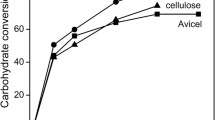Abstract
Spectroscopic characterization of both untreated and treated material is being performed in order to determine changes in the biomass and the effects of pretreatment on crystallinity, lignin content, selected chemical bonds, and depolymerization of hemicellulose and lignin. The methods used are X-ray diffraction for determination of cellulose crystallinity (CrI); diffusive reflectance infrared (DRIFT) for changes in C-C and C-O bonds; and fluorescence to determine lignin content. Changes in spectral characteristics and crystallinity are statistically correlated with enzymatic hydrolysis results to identify and better understand the fundamental features of biomass that govern its enzymatic conversion to monomeric sugars. Models of the hydrolysis initial rate and 72 h extent of conversion were developed and evaluated. Results show that the hydrolysis initial rate is most influenced by the cellulose crystallinity, while lignin content most influences the extent of hydrolysis at 72 h. However, it should be noted that in this study only crystallinity, lignin, and selected chemical bonds were used as inputs to the models. The incorporation of additional parameters that affect the hydrolysis, like pore volume and size and surface area accessibility, would improve the predictive capability of the models.
Similar content being viewed by others
References
Wyman, C. E. (1994), Ethanol from Lignocellulosic Biomass: technology, economics and opportunities, Biores. Techn. 50, 3–16.
Wyman, Charles (ed.), (1996), Handbook on Bioethanol: Production and Utilization, Taylor and Francis, Washington, DC, USA.
Buchanan, Bob B. Gruissem W., and Jones R. L. (2001), Biochemistry and Molecular Biology of Plants, 3rd ed. Courier Companies, Inc., 2001.
Sugiyama, J., Okano, T., Yamamoto, H., and Horii, F. (1990), Transformation of Valonia cellulose crystals by an alkaline hydrothermal treatment, Macromolecules 23, 2461–2498.
Chang, V. S., Barry Burr, and Mark T. Holtzapple. (1997), “Lime Pretreatment of Switchgrass”, Appl Biochem Biotechnol, 63–65, 3–19.
Holtzapple, M. T., Jun, J.-H., Ashok, G., Patibandla, S. L., and Dale, B. E. (1991), The ammonia freeze explosion (AFEX) process, Appl Biochem Biotechnol, 28/29, 59–74.
Yoon, H.H., Wu, Z.W. and Lee, Y.Y. (1995), Ammonia-recycled percolation process for pretreatment of biomass feedstock, Appl. Biochem. Biotechnol. 51/52, 5–19.
Hogan, C. M. and Mes-Hartree, M. (1990), Recycle of cellulases and the use of lignocellulosic residue for enzyme production after hydrolysis of steam-pretreated aspenwood, J. Ind. Microbiol. 6, 253–262.
Dale, B. E. and Moreira, M. J. (1983), Biotechnol. Bioengineer. Symp. 12, 13.
Holtzapple, M. T. and Torget, R. (1997), Thermal and biological processing, Appl. Biochem. Biotechnol. 63–65, 1–2.
Hespell, R. B., O’Bryan, P. J., Moniruzzaman, M., and Bothast, R. J. (1997), Hydrolysis by commercial enzyme mixtures of AFEX-treated corn fiber and isolated xylans, Appl. Biochem. Biotechnol. 62, 87–97.
Chang, V. S., Nagwani, M., and Holtzapple, M. T. (1998), Lime pretreatment of crop residues bagasse and wheat straw, Appl. Biochem. Biotechnol. 74, 135–159.
Segal, L., Creely, J. J., Martin, A. E., Jr., and Conrad, C. M. (1959), “An empirical method for estimating the degree of crystallinity of native cellulose using the X-ray diffractometer, Textile Res. J. 29, 786–794.
Wallace, G., Chesson, A., Lomax, J.A., and Jarvis, M.C. (1991), Lignin-carbohydrate complexes in graminaceous cell walls in relation to digestibility, Animal Feed Sci. Technol., 32, 193–199.
Jung, H. G., Mertens, D. R., and Payne, A. J. (1997), Correlation of acid detergent lignin and klason lignin with digestibility of forage dry matter and neutral detergent fiber, J. Dairy Sci. 80, 1622–1628.
Morrison, I. M. (1974), Structural investigations on the lignin-carbohydrate complexes from Lolium perenne, Biochem. J., 139, 197–204.
Lundquist, K., Josefsson, B., and Nyquist, G. (1978), Analysis of lignin products by fluorescence spectroscopy, Holzforschung, 32, 27–32.
Kong, F., Engler, C. R., and Soltes, E. J. (1992), Effects of cell-wall acetate, xylan backbone, and lignin on enzymatic hydrolysis of aspen wood, Appl. Biochem. Biotechnol. 34/35, 23–35.
Bertran, M. S. and Dale, B. E. (1985), Enzymatic hydrolysis and recrystallization behavior of initially amorphous cellulose, Biotechnol. Bioengineer, XXVII, 177–181.
Kendall, S. M. (1980), Multivariate Analysis 2nd ed., Macmillan Publishing, Co., New york.
Beebe, K. R. and Kowalski, B. R. (1987), An introduction to multivariate calibration and analysis, Analy. Chemi. 59, 1007A-1017A.
Thompson David N., Hsin-Chih Chen, and Hans Grethlein. (1992), “Comparison of Pretreatment Methods on the Basis of Available Surface Area”, Biores Technol, 39, 155–163.
Teymouri, F., Laureano-Perez, L., Alizadeh, H. and Dale, B. E. (2004), Ammonia fiber explosion treatment of corn stover, Appl. Biochem. Biotechnol. 113–116, 951–963.
Stewart, D., Wilson, H.M., Hendra, P.J. and Morrison, I.M. (1995), Fourier-transform infrared spectroscopic study of biochemical and chemical Treatments of oak wood (Quercus rubra) and barley (Hordeum vulgare) straw, J. Agric Food Chem. 43, 2219–2225.
Pandey, K.K. (1998), A study of chemical structure of soft and hardwood and wood polymers by FTIR sectroscopy, J. Appl. Polymer Sci. 71, 1969–1975.
http://permanent.access.gpo.gov/websites/www.olt.doe.sov/biofuels/asclytical_methods.html.
Author information
Authors and Affiliations
Corresponding author
Rights and permissions
About this article
Cite this article
Laureano-Perez, L., Teymouri, F., Alizadeh, H. et al. Understanding factors that limit enzymatic hydrolysis of biomass. Appl Biochem Biotechnol 124, 1081–1099 (2005). https://doi.org/10.1385/ABAB:124:1-3:1081
Issue Date:
DOI: https://doi.org/10.1385/ABAB:124:1-3:1081




